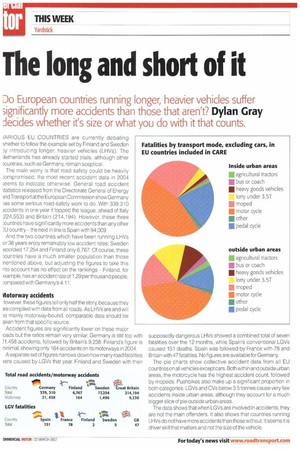The long and short of it
Page 22

If you've noticed an error in this article please click here to report it so we can fix it.
Do European countries running longer, heavier vehicles suffer significantly more accidents than those that aren't? Dylan Gray Jecides whether it's size or what you do with it that counts.
/ARIOUS EU COUNTRIES are currently debating is/nether to follow the example set by Finland and Sweden )y introducing longer, heavier vehicles (LHVs). The \letherlands has already started trials, although other .:ountries, such as Germany, remain sceptical.
The main worry is that road safety could be heavily )ompromised; the most recent accident data in 2004 3eems to indicate otherwise. General road accident ;tatistics released from the Directorate General of Energy 3.nd Transport at the European Commission show Germany as some serious road-safety work to do. With 339,310 Iccidents in one year it topped the league, ahead of Italy 224,553) and Britain (214,194). However, these three ountries have significantly more accidents than any other EU country -the next in line is Spain with 94,009.
And the two countries which have been running LHVs or 36 years enjoy remarkably low accident rates: Sweden ecorded 17,254 and Finland only 6,767. Of course, these ourtries have a much smaller population than those nentioned above, but adjusting the figures to take this nto account has no effect on the rankings Finland, for mample, has an accident rate of 1.29 per thousand people, :ompared with Germany's 4.11.
Vlotorway accidents
-lowever, these figures tell only half the story, because they ire compiled with data from all roads. As LHVs are and will De mainly motorway-bound, comparable data should be aken from that specific source.
Accident figures are significantly lower on these major Gads but the ratios remain very similar. Germany is still top with ?-1 ,458 accidents, followed by Britain's 9,238. Finland's figure is n in imal, showing only 164 accidents on its motorways in 2004.
A separate set of figures narrows down how many road fatalities vere caused by LGVs that year. Finland and Sweden with their supposedly dangerous LHVs showed a combined total of seven fatalities over the 12 months, while Spain's conventional LGVs caused 151 deaths. Spain was followed by France with 78 and Britain with 47 fatalities. No figures are available for Germany.
The pie charts show collective accident data from all EU countries on all vehicles except cars. Both within and outside urban areas, the motorcycle has the highest accident count, followed by mopeds. Pushbikes also make up a significant proportion in both categories. LGVs and CVs below 3.5 tonnes cause very few accidents inside urban areas, although they account for a much bigger slice of pie outside urban areas.
The data shows that when LGVs are involved in accidents, they are not the main offenders. It also shows that countries running LHVs do not have more accidents than those without. It seems it is driver skill that matters and not the size of the vehicle.


























































































































































































